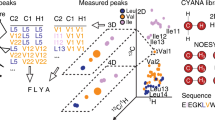Abstract
The low-density lipoprotein (LDL) receptor family members control diverse developmental and physiological pathways. Mesoderm development (MESD) protein is a 195-residue protein that functions as a specialized molecular chaperone to promote the proper folding of the six-bladed β-propeller/EGF modules of the LDL receptor family members. Here we report a complete NMR spectral assignment of the most conserved region of MESD protein, MESD(12-155).

Similar content being viewed by others
References
Culi J, Mann RS (2003) Boca, an endoplasmic reticulum protein required for wingless signaling and trafficking of LDL receptor family members in Drosophila. Cell 112:343–354
Culi J, Springer TA, Mann RS (2004) Boca-dependent maturation of beta-propeller/EGF modules in low-density lipoprotein receptor proteins. EMBO J 23:1372–1380
Herz J, Marschang P (2003) Coaxing the LDL receptor family into the fold. Cell 112:289–292
Howell BW, Herz J (2001) The LDL receptor gene family: signaling functions during development. Curr Opin Neurobiol 11:74–81
Hsieh JC, Lee L, Zhang L, Wefer S, Brown K, DeRossi C, Wines ME, Rosenquist T, Holdener BC (2003) Mesd encodes an LRP5/6 chaperone essential for specification of mouse embryonic polarity. Cell 112:355–367
Li Y, Chen J, Lu W, McCormick LM, Wang J, Bu G (2005) Mesd binds to mature LDL-receptor-related protein-6 and antagonizes ligand binding. J Cell Sci 118:5305–5314
Rudenko G, Henry L, Henderson K, Ichtchenko K, Brown MS, Goldstein JL, Deisenhofer J (2002) Structure of the LDL receptor extracellular domain at endosomal pH. Science 298:2353–2358
Sitia R, Braakman I (2003) Quality control in the endoplasmic reticulum protein factory. Nature 426:891–894
Strickland DK, Gonias SL, Argraves WS (2002) Diverse roles for the LDL receptor family. Trends Endocrinol Metab 13:66–74
Villeger L, Abifadel M, Allard D, Rabes JP, Thiart R, Kotze MJ, Beroud C, Junien C, Boileau C, Varret M (2002) The UMD-LDLR database: additions to the software and 490 new entries to the database. Hum Mutat 20:81–87
Acknowledgements
This work was supported by NIH RO1 grants (HL074365 and HL076620 to J.W.). Jianglei Chen is supported by a predoctoral fellowship from the American Heart Association (AHA 0515582Z to J.C.).
Author information
Authors and Affiliations
Corresponding author
Rights and permissions
About this article
Cite this article
Chen, J., Bu, G. & Wang, J. A complete NMR spectral assignment of the conserved region of the MESD protein, MESD(12-155). Biomol NMR Assign 1, 3–5 (2007). https://doi.org/10.1007/s12104-007-9003-6
Accepted:
Published:
Issue Date:
DOI: https://doi.org/10.1007/s12104-007-9003-6




